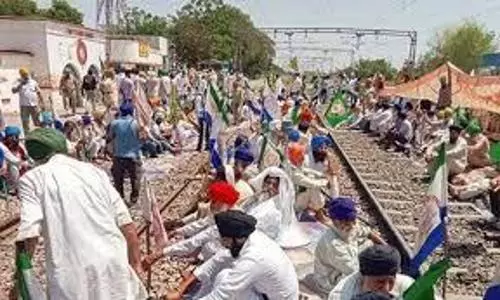
Yashwant Sinha report and Kashmir unrest
text_fieldsOne of the key objectives of note-ban announced by the Prime Minister Narendra Modi on November 8, last year, was to curb the funding for terror organisations.
It has now been proved that demonetization of Rs 500 and 1000 currency notes was his decision alone and not that of the Reserve Bank of India as the government claims. The move was claimed to be a success with the curtailing of terrorist activities in Jammu and Kashmir and normalcy in the state restored. Nobody bothered to confirm the veracity of PM’s assertions. The economic survey of 2016 presented by the Finance Minister of the state Haseeb Drabu in the assembly reveals that the loss to the public exchequer within five months of unrest that prevailed following the death of Jammu and Kashmir Hizbul Mujahideen commander Burhan Wani, was Rs 16, 000 crore.
 According to the survey report, the economic activities underwent a near stagnation in the conflict during which many civilians were killed and several injured. Phone and internet services were suspended which made telecommunication almost impossible. The report also points out that hartals, bandhs, curfews and other restrictions imposed made the lives of the people in the ten districts in the Valley miserable. The encounters between the security forces and terrorists are being perpetually continued and news reports about the loss of lives are surfacing daily. It implies that the demonetization of the currency notes have failed to bring about any benefits even in the field of safety.
According to the survey report, the economic activities underwent a near stagnation in the conflict during which many civilians were killed and several injured. Phone and internet services were suspended which made telecommunication almost impossible. The report also points out that hartals, bandhs, curfews and other restrictions imposed made the lives of the people in the ten districts in the Valley miserable. The encounters between the security forces and terrorists are being perpetually continued and news reports about the loss of lives are surfacing daily. It implies that the demonetization of the currency notes have failed to bring about any benefits even in the field of safety.
It’s during these circumstances, that a team led by former External Affairs Minister and senior BJP leader Yashwant Sinha, visited the Valley twice to assess the situation after months of conflict in the region. Following the fact-finding mission facilitated by the Centre for Dialogue and Reconciliation, an organization based in Delhi that has been working in Kashmir for more than a decade, the group released a study report on the reason behind the Kashmir unrest, in two phases.
 The Kashmiris believe that the approach of the Centre, of looking at the Kashmir issue only within the framework of national security, is what was preventing the problem from being resolved. They feel that the government refuses to recognize Kashmir as a political problem which requires a political solution. The Kashmiris claim that they have lost faith in India. Vajpayee’s proposal of resolving the Kashmir issue “within the ambit of humanity” had offered a ray of hope. However, the present government in Delhi, according to the Kashmiri people, weren’t interested in that approach.
The Kashmiris believe that the approach of the Centre, of looking at the Kashmir issue only within the framework of national security, is what was preventing the problem from being resolved. They feel that the government refuses to recognize Kashmir as a political problem which requires a political solution. The Kashmiris claim that they have lost faith in India. Vajpayee’s proposal of resolving the Kashmir issue “within the ambit of humanity” had offered a ray of hope. However, the present government in Delhi, according to the Kashmiri people, weren’t interested in that approach.
While many believe that India is deliberately pretending to ignore the sentiments of the Kashmiris, most of them claim that their protests were neither ‘sponsored’ by anyone nor were their youngsters being paid to come out in the streets. They have anger towards RSS Chief Mohan Bhagwat coming to Jammu and claiming that India was a “Hindu Rashtra”. They ask what the Kashmiri Muslims could expect from Modi if he cannot protect or react to the killing of Mohammed Akhlaq who was beaten to death for rumours of consuming beef. Given that 68 per cent of the Kashmir’s population comprises of youth, the Kashmiris say that the government should be talking to them. They believe that the present stone-pelting and street protests would not last for long. However, there are apprehensions among the people that something untoward would happen once the spring sets in after April 2017.
 The team in their extensive report put forward some suggestions. It reiterates the suggestions of the Kashmiri people that the local parties or groups in the state cannot resolve the complex political issue of Kashmir. It could be solved only when all the three stakeholders, India, Pakistan and the people of Jammu and Kashmir address the issue. The report also says that peace wouldn’t be restored until all the three parties give up their rigid stand and show flexibility. Improving the human rights situation in Kashmir was the first thing to be done immediately. Process of interaction and discourses between the civil society groups and the rest of India should also be institutionalised.
The team in their extensive report put forward some suggestions. It reiterates the suggestions of the Kashmiri people that the local parties or groups in the state cannot resolve the complex political issue of Kashmir. It could be solved only when all the three stakeholders, India, Pakistan and the people of Jammu and Kashmir address the issue. The report also says that peace wouldn’t be restored until all the three parties give up their rigid stand and show flexibility. Improving the human rights situation in Kashmir was the first thing to be done immediately. Process of interaction and discourses between the civil society groups and the rest of India should also be institutionalised.
The hard core BJP government who speaks only in the language of power, use of force and military tactics believes that all issues could be resolved through extremist strategies. How far the Centre could be expected to favourably respond to these suggestions is yet to be seen.























